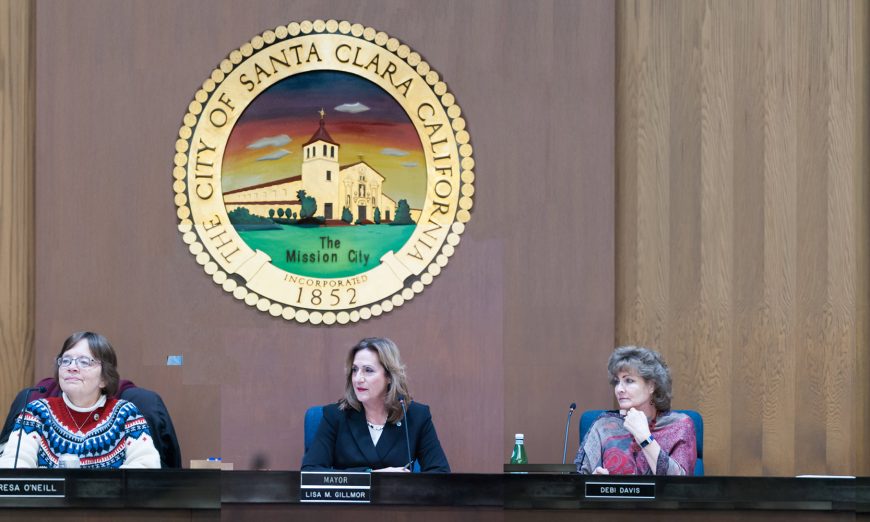If there was one single takeaway from the City Council’s annual goal-setting meeting it is that City employees have to focus almost exclusively on delivering services — operations — at the expense of strategic planning and process improvement.
As they did last year, the Council got another big helping of reality pie about the state of the City, as well as detailed reports on every department in the City.
Last year the focus of the two-day session was process: the risk and inefficiency inherent in the City’s manual, decentralized and in many cases autopilot operations. This year the focus was on trying to get the work of the City done with a staff that was at least 100 people fewer than the work required.
City Manager Deanna Santana often emphasizes that “governance needs to be intentional.” A city Santa Clara’s size can’t operate with unwritten policies. The Council can establish any policy they want, but all policy must be “intentional” and properly documented.
Santana also admonished the Council that, “I don’t want to continue the practice of setting priorities without assigning resources.” As it turned out, the meeting ran so long that there was no time for any priority setting by the Council and this was postponed to an undetermined future date.
Santana kicked things off with a “context-setting” quote: “you can’t do today’s job with yesterday’s methods and be in business tomorrow.” Santana has divided Santa Clara’s goal of “being in business tomorrow” into three categories of effort: process, people and performance.
Progress has been made on City processes since last year. The City hired four new managers: a public records manager; a city auditor; a risk manager; and a purchasing and contracts manager.* Progress has also been made in centralizing processes such as purchasing, streamlining business processes and creating standard procedures, and instituting auditing processes appropriate to Santa Clara’s size and complexity.
However, for a city its size that operates an electric utility, a major league sports stadium and a convention center, Santa Clara is acutely understaffed in Santana’s analysis.
With a population twice that of Palo Alto’s, Santa Clara has fewer fulltime employees — excluding public safety and the electric utility — than Palo Alto: 616 compared to Palo Alto’s 742.
Sunnyvale — with about 30,000 more people, but no electric utility, convention center or stadium — has almost 100 more employees than Santa Clara.
In short, capacity is less than workload. Despite “the commitment of our workforce,” which was “certainly doing more with a lot less,” Santana said, with 90 percent of City staff dedicated to daily operations, there is little time left for automating manual procedures, streamlining those operations and strategic planning.
For example, the City’s finance system wasn’t designed for local government accounting and requires time-consuming and ultimately costly workarounds. Fiscal and administrative processes “are antiquated and labor intensive,” Finance Director Angela Kraetch told the Council, and finance was a “paper heavy organization with manual processes.”
Another example is the City’s seven-person IT department which is “implementing 34 system upgrades or replacements at once,” Santana said. The City has purchased the NextRequest system to automate the handling of public records requests, said Santana. But, “We don’t have staff in place [to implement it] because we are bogged down with …responding to the records.”
The number of staff reports in Council agendas has increased about 20 percent, Santana said. She also noted that the number of Council meetings has increased more than 60 percent since 2013. Santana noted that as of that day (Thursday) “staff already put in 40 hours. We had a 17-hour day on the Council [meeting] day alone.”
Vice Mayor Patricia Mahan noted that “pretty significant external causes” — including the dot-com bust in 2001 and the recession following the September 11 attacks, the Great Recession that began in 2008 and the dissolution of the redevelopment agency cutting the City’s lease revenues — that “put us in the situation that we are here right now. I really applaud our staff efforts especially led by the executive team in leading us out of this situation.”
The combination of workload and out-of-date methods has another impact on City services and operations, said Santana.
Combined with the area’s stratospheric cost of living and very low unemployment rate, these conditions make it even harder to attract and retain experienced employees. For the first time in 10 years, last year the number of employees who left for other jobs was higher than the number retiring.
Space is also a challenge at City Hall, and records rooms are being converted to offices. The planned — but only partially funded — new utilities office building will also open more office space as well as saving the City money.
That short term plan, said Santana, is part of a longer term Civic Center master plan defining “the long-term land use” for the City Hall property and the financing for such a plan, which might include selling some of the City’s property — for example, acreage that Silicon Valley Power owns in the town of Loyalton.
The City will launch the long term Civic Center planning in the next few months, which will include financing and land use.
Upcoming, we’ll have an overview of the City departmental reports as well as key statistics about the City’s finance and infrastructure.
You can watch the meeting videos and read meeting transcripts, presentations and reports at santaclara.legistar.com/Calendar.aspx.
* In the past the City Clerk was also the city auditor and public records manager. Individual departments controlled their contracts and purchasing, with citywide contracts falling in no one’s bailiwick.






